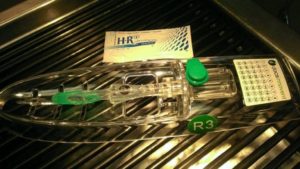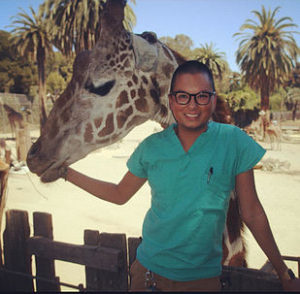Old school and new school in airway management
Stephen Cital RVT, SRA, RLAT
United Veterinary Specialty and Emergency, Oakland Zoo, San Francisco Zoo
Posted on 2016-09-22
It feels like every year we are bombarded with new products that will “revolutionize” the way we practice medicine. A product called the V-gel® caught my eye as an exotics and anesthesia guy back in 2014. The V-gel is a veterinary specific supraglottic airway device, also known as a laryngeal mask airway (LMA).
 The company that makes the V-gel, Docsinnovent®, currently has products for two species on the market, one for rabbits (Fig. 1) and one for cats. The company has made soft announcements of a canine, guinea pig and equine specific model in the near future. Before I continue, it is imperative that, as rational, intelligent and ethical practitioners, we evaluate each product we use very carefully, especially since one of our negative outcomes can be death of a patient. It is also imperative to overcome the hypnosis of sales representatives who are paid to market and sell a product with little to no experience after they catch us in a post-prandial state while walking through the conference exhibit floor.
The company that makes the V-gel, Docsinnovent®, currently has products for two species on the market, one for rabbits (Fig. 1) and one for cats. The company has made soft announcements of a canine, guinea pig and equine specific model in the near future. Before I continue, it is imperative that, as rational, intelligent and ethical practitioners, we evaluate each product we use very carefully, especially since one of our negative outcomes can be death of a patient. It is also imperative to overcome the hypnosis of sales representatives who are paid to market and sell a product with little to no experience after they catch us in a post-prandial state while walking through the conference exhibit floor.
Let’s start with the familiar. Traditional endotracheal intubation offers several benefits when it comes to anesthetic and resuscitative measures.
- A direct airway and reasonable protection from gastric or other fluid aspiration
- Effective ventilation and oxygenation
- Ability to suction the airway
- Delivery of anesthetic and other drugs through the endotracheal tube in emergencies
Some of the more lasting negative outcomes include:
- Inner tracheal lumen mucosal damage
- Respiratory resistance while intubated
- Increased dead space
- Focal ischemia and necrosis, tracheal tearing, tracheitis from traumatic placement and possibly secondary tracheal strictures
Appropriate technique, proper laryngoscopy placement, and management of staff performing the procedure can mitigate most of these risk factors.
Now the new school approach. When it comes to LMAs, we also have risk factors. Some of the more concerning are:
- Pharyngeal or laryngeal trauma
- Focal ischemia and necrosis
- Aerophagia
- Aspiration
- Anesthetic gas leakage
- Complete airway obstruction
- Lingual swelling with prolonged use
As with traditional endotracheal intubation, most of these complications are associated with incorrect placement and sizing of the device. Because LMAs are still new to the veterinary world, we are met with a new learning curve regarding appropriate size and fit. Luckily, the V-gel have a sizing chart that can give a guideline for choosing the right tube based on patient weight. However, this sizing chart also has associated drawbacks, especially with obese or gravid patients. Choosing the right LMA should be based on the patient’s ideal weight. Other concerns associated with LMAs are the wide range of anatomical differences among breeds of rabbits and cats, in particular, brachycephalic breeds.
 Human patients also complain of a sore throat and the feeling of pressure in the oropharyngeal space up to 72 hours after removal of the LMA, but this is also common with traditional endotracheal intubation. Human LMAs (Fig. 2), although used by some veterinary practitioners, are not designed for veterinary species and cannot be ethically advocated.
Human patients also complain of a sore throat and the feeling of pressure in the oropharyngeal space up to 72 hours after removal of the LMA, but this is also common with traditional endotracheal intubation. Human LMAs (Fig. 2), although used by some veterinary practitioners, are not designed for veterinary species and cannot be ethically advocated.
Laryngeal mask airways do have a place in our ever-growing toolkit. They are perfect for non-invasive procedures like CT or MRI scans, patients undergoing radiation or animals that need to be anesthetized semi-regularly, such as in the research setting.
The V-gels are excellent for the initiation of CPR. I personally find them particularly helpful in intubating rabbits, which are historically difficult to intubate. A stylet can be passed through the V-gel, then the V-gel is removed and an endotracheal tube is passed over the stylet, which is then removed once the patient is intubated. The devices are also useful in practices that rarely see rabbit patients or there is no staff appropriately trained in rabbit intubation. However, I would argue that these are the opportunities to learn.
Certain risk factors or procedures should exclude the use of LMAs, some of which include dental procedures, patients expected to have reflux, patients with laryngeal spasm, and procedures where the head will be manipulated or neck bent. Considerations need to be made if a mechanical ventilator is expected to be used as an excellent seal in imperative.
About the author
I instead became a Registered Veterinary Technician and enrolled in a Bachelors of Health Science degree program, not wanting to waste my already hard earned credits. I then obtained certification as a Surgical Research Anesthetist through the Academy of Surgical Research, followed by the designation of a Registered Laboratory Animal Technician through the American Association of Laboratory Animal Science. This September I plan to sit for the Certified Veterinary Pain Practitioner exam through the International Veterinary Academy of Pain Management. I currently am the chair of the organizing committee for the proposed Academy of Laboratory Animal Veterinary Technicians and Nurses seeking Veterinary Technician Specialty (VTS) status from NAVTA/AVMA.
|


 I have been working in the veterinary field since high school starting as a kennel assistant. I did this knowing I would be exposed to interesting medical procedures in hopes of familiarizing myself before moving on to humans. Or so the plan was. Originally starting college to become an RN this goal vanished after finding my real interest, veterinary medicine. This, of course, was after I had to start touching peoples’ feet and watching my mother give birth twice, among other gross human things…
I have been working in the veterinary field since high school starting as a kennel assistant. I did this knowing I would be exposed to interesting medical procedures in hopes of familiarizing myself before moving on to humans. Or so the plan was. Originally starting college to become an RN this goal vanished after finding my real interest, veterinary medicine. This, of course, was after I had to start touching peoples’ feet and watching my mother give birth twice, among other gross human things…
